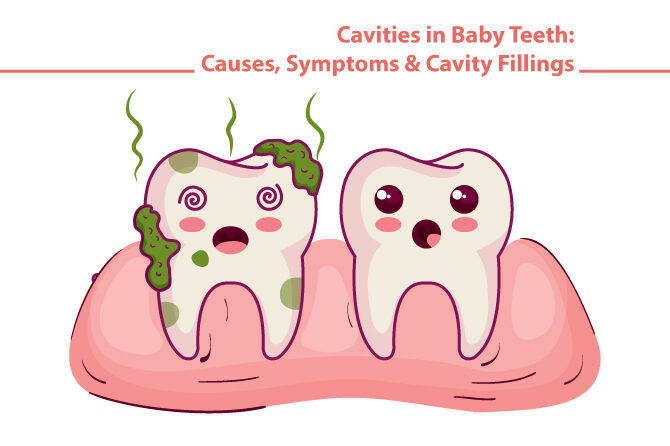
Cavities in Baby Teeth: Causes, Symptoms & Cavity Fillings
The most prevalent chronic illness in kids is tooth decay. In today’s world, cavities in baby teeth are unfortunately quite common. Baby teeth are important for chewing, speaking, and guiding permanent teeth into the correct position, so it’s important to take care of them even though adult teeth will eventually replace them.
Several factors can contribute to tooth decay in baby teeth, including poor oral hygiene, frequent snacking or sipping on sugary drinks, and not getting enough fluoride treatment. Establishing good oral hygiene habits early on, including regular brushing and flossing, and limiting sugary or acidic foods and drinks is important. It’s also a good idea to schedule regular dental check-ups for your child, starting from their first tooth or their first birthday, and help prevent and catch any dental issues early on.
Effects of Cavities on Baby Teeth
Cavities in baby teeth can cause several problems for children. If they are left untreated, the cavities in baby teeth can lead to:
- Pain and discomfort: The child may experience pain or sensitivity when eating or drinking, which can affect their ability to eat and drink properly
- Tooth decay: The cavity can continue to spread and damage the tooth structure, leading to tooth decay and eventual loss of the tooth
- Infection: If the cavity reaches the inner layer of the tooth (pulp), it can cause an infection that can spread to the surrounding tissues and cause swelling and pain
- Difficulty with speech: Cavities in baby teeth can affect the child’s speech development and pronunciation
- Difficulty with biting and chewing: Cavities in baby teeth can make it difficult for the child to bite and chew properly, affecting their overall nutrition.
It’s important to take care of baby teeth, as they play a crucial role in maintaining the spacing treatment for adult teeth and are also important for chewing and speaking. If you suspect your child has cavities, seeing a dentist as soon as possible is essential.
Cavities Causes
There are several causes of cavities in baby teeth, including:
- Poor oral hygiene: Failure to brush and floss regularly can allow plaque to build up on the teeth, leading to decay
- Frequent snacking or sipping on sugary drinks: When children eat or frequently drink throughout the day, especially sugary or acidic foods and drinks, it increases the risk of decay
- Lack of fluoride: Fluoride helps strengthen tooth enamel and prevent decay. Children who don’t get enough fluoride from drinking water or fluoride varnish treatments may be more susceptible to cavities
- Early exposure to sugary or acidic foods and drinks: Children exposed to sugary or acidic foods and drinks at a young age may be more likely to develop cavities
- Genetics: Some children may be more prone to cavities due to their genetic makeup
Establishing good oral hygiene habits early on, including regular brushing and flossing, and limiting sugary or acidic foods and drinks is important. It’s also a good idea to schedule regular dental checkups for your child, starting from their first tooth or their first birthday, and help prevent and catch any dental issues early on.
Cavities Symptoms
Cavities in baby teeth can cause a range of symptoms, including:
- Tooth sensitivity or pain: If the cavity is causing damage to the tooth’s nerve, your child may experience sensitivity or pain when eating or drinking sweet, hot, or cold foods and drinks.
- Visible holes or brown spots: You may be able to see small holes or brown spots on the surface of the affected tooth
- Tooth decay: The decay may cause the tooth to become weak and brittle, eventually breaking or falling out
- Bad breath: Decay in the tooth can cause bad breath or a bad taste in the mouth
- Pain when biting: If the cavity is large enough, your child may experience pain when biting or chewing food
Taking your child to a dentist for a proper diagnosis and treatment of cavities in baby teeth is important. If left untreated, cavities can lead to more serious dental problems, including infections, gum disease, and loss of the affected tooth.
What are Cavity Fillings?
A cavity filling is a dental treatment used to restore a damaged or decayed tooth. When a tooth has a cavity, the decay can penetrate the outer enamel and dentin layers and reach the inner pulp, where the nerves and blood vessels are located. If left untreated, this can cause pain, infection, and even tooth loss.
Cavity fillings are used to remove the decayed portion of the tooth and fill the space with a material that will prevent further decay and restore the tooth’s normal function and appearance. The most common materials used for cavity fillings include amalgam (silver), composite (tooth-colored), gold, and porcelain.
Conclusion
Kids Dental Studio is kid-friendly, and there are several games for youngsters to play in the waiting room. The clinic’s operatory room, which includes two dental chairs and is well-stocked with modern dental supplies and tools, allows for speedy and comfortable dental care for children. Our goals are to provide a pleasant dental experience, uphold the standard of dental care, and foster a favorable attitude towards dental care so that subsequent dental appointments will also be pleasurable.
Leave a reply